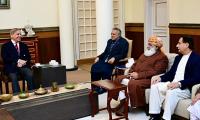ISLAMABAD: Pakistan’s ability to generate foreign loans shrank significantly up to 50 percent in the first seven months (July-Jan) period of the current fiscal year compared to the same period of the last financial year mainly because of stalled IMF programme.
According to official data of the government, the dollar inflows on account of foreign loans and grants have witnessed downslide of approximately 50 percent during July-January period of FY2022-23 as it declined to $6.1 billion in the current fiscal against $12.02 billion in the same period of the last financial year.
To be exact, the foreign dollar inflows decreased by 48.89 percent in the first seven months of the current fiscal year compared to the same period of the last financial year.
The government sought $22.8 billion on the eve of the budget for 2022-23 but, so far, the disbursements of dollar inflows remained dismally slow. This slow disbursement of inflows aggravated the dollar liquidity crunch and now Pakistani authorities are pinning hopes that Pakistan and the IMF might strike a staff level agreement next week.
A major decline has been witnessed on account of foreign commercial loans as the government could fetch only $200 million in the first seven months of the current fiscal against $2.62 billion in the same period of the last financial year. The government received $1.16 billion from the IMF in the current fiscal year. Through the Naya Pakistan Certificate, the government fetched $466.3 million in the current fiscal year.
This massive drop in the dollar inflows simply depicts that the country has been passing through severe dollar liquidity crunch resulting into persistent decline in the foreign exchange reserves held by the State Bank of Pakistan (SBP). The foreign exchange reserves held by the SBP stood at $10.8 billion in last April 2022 when the PTI’s former prime minister Imran Khan was shown the door through a no confidence move. Now the foreign exchange reserves held by the SBP stood at $3.1 billion in accordance with the data released by the central bank last week.
If the official data is scrutinized for detailed analysis, it shows that total disbursements from the multilateral creditors stood at $3.46 billion during July-Jan period of the current fiscal year against $3.32 billion in the same period of the last financial year.
The Asian Development Bank (ADB) has disbursed $1.31 billion in the first seven months of the ongoing financial year compared to $1.09 billion in the same period of the last financial year.
The Asian Infrastructure Investment Bank (AIIB) disbursed $538.46 million in the first seven months of the current fiscal year against $38.77 million in the same period of the last financial year. The EIB has disbursed $13.37 million in the first seven months of the current fiscal year against zero disbursement in the same period of the last financial year. The European Union did not disburse any amount in the current fiscal year so far against $22.5 million in the same period of the last financial year.
The World Bank provided $684.14 million as IDA funding and $36.5 million as IBRD funding. The IFAD has disbursed $35 million in the first seven months of the current fiscal year. The Islamic Development Bank (IsDB) provided to the tune of $161 million.
Among the bilateral partners, Kingdom of Saudi Arabia has become the largest bilateral donor as it provided $690 million in the first seven months of the current fiscal year on account of oil facility on deferred payment.
The other bilateral donors also provided much needed dollar inflows as China provided $54.93 million, France $21.9 million, Germany $4.6 million, Italy $5.45 million, Japan $21.3 million, Korea $19.79 million, Oman $1.89 million and USA $18.74 million.
Justice Abdul Shakoor Paracha fixes hearing on December 24 regarding Islamabad constituencies
Police made one arrest after vehicle drove “at least 400 metres across the Christmas market”
Incident occurred when couple, along with their child, was travelling in their car
Congress party dismisses incident as political gimmick
"I am sure once negotiations start, things will move forward," says NA speaker
Discussion focuses on enhancing governance, accountability and functional autonomy within police







